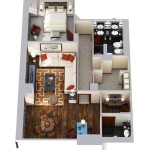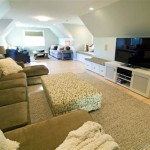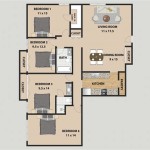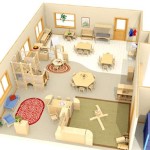A home office floor plan is a layout that designates a specific area of a home for work-related activities. It is a blueprint that defines the arrangement of furniture, equipment, and other elements within the home office space for optimal functionality and productivity.
Creating an efficient home office floor plan is essential for several reasons. First, it helps to establish a dedicated workspace, separating work from personal life. A well-planned layout can maximize the use of available space, creating a comfortable and organized environment conducive to focus.
In the following sections, we will delve into the key principles and considerations for designing an effective home office floor plan, exploring different layout options, furniture and equipment placement, and tips for optimizing storage and functionality.
Designing an effective home office floor plan involves considering several key aspects. Here are nine important points to keep in mind:
- Space utilization
- Furniture placement
- Equipment layout
- Storage solutions
- Lighting conditions
- Ergonomic considerations
- Visual appeal
- Flexibility and adaptability
- Personalization and comfort
By taking these factors into account, you can create a home office floor plan that meets your specific needs and preferences, fostering productivity and well-being.
Space utilization
Effective space utilization is crucial for creating a functional and comfortable home office. The available space should be used wisely to accommodate all necessary elements without creating a cluttered or cramped environment.
Start by determining the essential furniture and equipment for your home office. Consider the size and shape of your workspace and choose pieces that fit comfortably within the space. Multi-purpose furniture, such as a desk with built-in storage, can help save space and keep the area organized.
Vertical space is often overlooked, but it can be a valuable asset in a home office. Shelves, wall-mounted cabinets, and floating desks can help you store items and keep your work surface clear. Consider using stackable bins or drawers to organize supplies and documents efficiently.
Another way to maximize space utilization is to use dividers or screens to create separate work zones. This can help define different areas for specific tasks, such as a desk area, a storage area, and a relaxation area. By dividing the space into smaller sections, you can create a more organized and productive environment.
Finally, consider the flow of movement within your home office. Make sure there is enough space to move around comfortably and access all necessary areas. Avoid placing furniture or equipment in high-traffic areas or blocking doorways.
Furniture placement
Furniture placement is a critical aspect of home office floor planning. The arrangement of furniture should be carefully considered to create a functional, comfortable, and visually appealing workspace.
- Desk placement
The desk is the central element of most home offices. It should be placed in a well-lit area with a clear view of the room. Avoid placing the desk directly in front of a window, as this can cause glare. If possible, position the desk so that you can face the door when seated. This will give you a sense of control and allow you to see who is entering the room. - Chair selection and placement
The chair is another important piece of furniture in the home office. Choose a chair that is comfortable and provides good back support. Adjust the chair to the correct height so that your feet are flat on the floor and your thighs are parallel to the ground. The chair should be placed close enough to the desk so that you can reach the keyboard and mouse comfortably. - Storage solutions
Storage is essential in any home office. Choose storage solutions that fit your needs and the available space. Vertical storage, such as shelves and wall-mounted cabinets, can help save floor space. Consider using stackable bins or drawers to organize supplies and documents efficiently. - Other furniture
In addition to the desk, chair, and storage solutions, you may also want to include other furniture in your home office, such as a bookcase, filing cabinet, or sofa. Arrange these pieces in a way that maximizes space utilization and creates a comfortable and functional workspace.
By carefully considering furniture placement, you can create a home office that meets your specific needs and preferences, fostering productivity and well-being.
Equipment layout
Equipment layout is another important consideration for home office floor planning. The arrangement of equipment should be carefully considered to create a functional, efficient, and visually appealing workspace.
- Computer placement
The computer is the central piece of equipment in most home offices. It should be placed in a well-lit area with a clear view of the room. Avoid placing the computer directly in front of a window, as this can cause glare. The computer should be positioned so that the screen is at eye level and the keyboard and mouse are within easy reach.
- Printer placement
The printer is another essential piece of equipment for many home offices. It should be placed in a convenient location that is close to the computer. Avoid placing the printer in a high-traffic area or where it will block access to other equipment.
- Other equipment
In addition to the computer and printer, you may also have other equipment in your home office, such as a scanner, fax machine, or copier. These pieces of equipment should be placed in a way that maximizes space utilization and creates a comfortable and functional workspace.
- Cable management
Cable management is an important aspect of equipment layout. Loose cables can be unsightly and hazardous. Take the time to organize and manage your cables using cable ties, cord organizers, or under-desk cable trays. This will help to keep your workspace neat and tidy, and it will also reduce the risk of tripping or damaging your equipment.
By carefully considering equipment layout, you can create a home office that meets your specific needs and preferences, fostering productivity and well-being.
Storage solutions
Storage solutions are essential for any home office. They help to keep your workspace organized and clutter-free, which can improve productivity and focus. There are a variety of storage solutions available, so you can choose the ones that best fit your needs and the available space.
- Shelving
Shelving is a versatile storage solution that can be used to store a variety of items, such as books, files, supplies, and equipment. Shelves can be mounted on the wall or placed on the floor. They come in a variety of sizes and styles, so you can find ones that fit your space and needs.
- Cabinets
Cabinets are another great storage solution for home offices. They come in a variety of sizes and styles, so you can find ones that fit your space and needs. Cabinets can be used to store a variety of items, such as files, supplies, and equipment. Some cabinets have doors, while others have drawers. Choose the type of cabinet that best suits your needs.
- Drawers
Drawers are a great way to store small items, such as pens, pencils, paper clips, and other supplies. Drawers can be placed on desks, tables, or in cabinets. They come in a variety of sizes and styles, so you can find ones that fit your needs.
- Baskets and bins
Baskets and bins are a great way to store larger items, such as blankets, pillows, and toys. Baskets and bins can be placed on the floor, in closets, or on shelves. They come in a variety of sizes and styles, so you can find ones that fit your needs.
By choosing the right storage solutions, you can create a home office that is organized, efficient, and stylish.
Lighting conditions
Lighting conditions are an important consideration for any home office. The right lighting can help to reduce eye strain, improve productivity, and create a more comfortable and inviting workspace.
- Natural light
Natural light is the best type of lighting for any workspace. It is bright and evenly distributed, and it can help to reduce eye strain and improve mood. If possible, position your home office near a window to take advantage of natural light. However, avoid placing your desk directly in front of a window, as this can cause glare.
- Artificial light
When natural light is not available, artificial light is necessary. Choose a bright, evenly distributed light source that will not cause glare. Avoid using harsh or flickering lights, as these can be fatiguing to the eyes. Consider using a combination of overhead lighting and task lighting to create a well-lit workspace.
- Task lighting
Task lighting is a focused light source that can be used to illuminate specific work areas, such as a desk or a drafting table. Task lighting can help to reduce eye strain and improve productivity. Choose a task light that is adjustable so that you can direct the light where it is needed.
- Ambient lighting
Ambient lighting is a general light source that provides overall illumination for a space. Ambient lighting can be provided by overhead lighting or by lamps placed around the room. Choose an ambient light source that is bright enough to see clearly, but not so bright that it is glaring or fatiguing to the eyes.
By considering the lighting conditions in your home office, you can create a workspace that is comfortable, productive, and inviting.
Ergonomic considerations
Ergonomic considerations are important for any workspace, but they are especially important for home offices. This is because we often spend long hours working in our home offices, and poor ergonomics can lead to pain, discomfort, and even injury.
- Chair
Your chair is one of the most important pieces of furniture in your home office. It should be comfortable and supportive, and it should allow you to maintain good posture. Look for a chair with adjustable seat height, backrest, and armrests. The seat should be firm enough to provide support, but not so firm that it is uncomfortable. The backrest should support your lower back and allow you to sit up straight. The armrests should be positioned so that your elbows are bent at a 90-degree angle when you are typing.
- Desk
Your desk should be the right height for you so that your elbows are bent at a 90-degree angle when you are typing. The desk should also be deep enough so that you have plenty of room to work. If your desk is too high or too low, you can use a footrest or a keyboard tray to adjust the height. You may also want to use a standing desk converter to alternate between sitting and standing while you work.
- Computer
Your computer monitor should be positioned so that the top of the screen is at or slightly below eye level. The monitor should also be far enough away from you so that you can see the entire screen without having to turn your head. You may need to use a monitor stand to adjust the height of your monitor.
- Keyboard and mouse
Your keyboard and mouse should be positioned so that your wrists are in a neutral position. This means that your wrists should be straight and your forearms should be parallel to the floor. You may need to use a keyboard tray or a wrist rest to adjust the position of your keyboard and mouse.
By following these ergonomic considerations, you can create a home office that is comfortable, productive, and healthy.
Visual appeal
Visual appeal is an important consideration for any home office floor plan. After all, you spend a lot of time in your home office, so it should be a space that you enjoy being in. Here are a few tips for creating a visually appealing home office:
Choose a color scheme that you love. The colors in your home office should reflect your personality and style. If you prefer a calming environment, choose soft, neutral colors. If you prefer a more energetic environment, choose brighter, bolder colors. You can also use color to create different zones in your home office, such as a work zone, a relaxation zone, and a storage zone.
Add personal touches. Your home office should be a reflection of you, so add personal touches that make it feel like your own. This could include photos of your family and friends, artwork that you love, or plants that bring life to the space. Personal touches will make your home office a more inviting and comfortable place to work.
Keep it organized. A cluttered home office is not only visually unappealing, but it can also be distracting and inefficient. Take the time to declutter your home office and keep it organized. This will make it a more pleasant place to work and it will also help you to be more productive.
Add some greenery. Plants can add life and vitality to any space, including your home office. Adding a few plants to your home office can help to improve air quality, reduce stress, and boost creativity. Plus, they look great!
Flexibility and adaptability
In today’s rapidly changing world, it’s more important than ever to have a home office that is flexible and adaptable. This means creating a space that can easily be reconfigured to meet your changing needs. For example, you may need to be able to quickly convert your home office into a guest room or a playroom for your children. Or, you may need to be able to adjust the layout of your home office to accommodate new equipment or furniture.
There are a few key things to keep in mind when designing a flexible and adaptable home office. First, choose furniture that is easy to move and reconfigure. Second, use modular storage solutions that can be easily added to or rearranged. Third, make sure that your home office has plenty of natural light and ventilation, as this will make it more comfortable and inviting to work in.
Here are a few specific tips for creating a flexible and adaptable home office:
- Choose furniture that is easy to move and reconfigure. Avoid heavy, bulky furniture that is difficult to move around. Instead, opt for lightweight furniture that can be easily rearranged to create different layouts.
- Use modular storage solutions. Modular storage solutions are great for creating a flexible and adaptable home office. This is because modular storage units can be easily added to or rearranged to create different configurations. This allows you to customize your storage space to meet your changing needs.
- Make sure that your home office has plenty of natural light and ventilation. Natural light and ventilation will make your home office more comfortable and inviting to work in. If possible, position your home office near a window to take advantage of natural light. You may also want to consider adding a ceiling fan or air conditioner to improve ventilation.
By following these tips, you can create a home office that is both flexible and adaptable. This will allow you to easily reconfigure your home office to meet your changing needs, making it a more comfortable and productive space to work in.
Personalization and comfort
Personalization and comfort are essential for creating a home office that you enjoy working in. After all, you spend a lot of time in your home office, so it should be a space that reflects your personality and style. It should also be a space that is comfortable and conducive to productivity.
- Choose furniture that is comfortable and supportive.
The chair you sit in and the desk you work at are two of the most important pieces of furniture in your home office. Make sure that they are comfortable and supportive. The chair should provide good back support and the desk should be the right height for you to work comfortably. You may also want to consider adding a footrest or a standing desk converter to improve your comfort.
- Add personal touches.
Your home office should be a reflection of you, so add personal touches that make it feel like your own. This could include photos of your family and friends, artwork that you love, or plants that bring life to the space. Personal touches will make your home office a more inviting and comfortable place to work.
- Make sure your home office is well-lit and ventilated.
Natural light and ventilation are essential for creating a comfortable and productive home office. If possible, position your home office near a window to take advantage of natural light. You may also want to consider adding a ceiling fan or air conditioner to improve ventilation.
- Minimize distractions.
A cluttered or noisy home office can be distracting and make it difficult to focus on your work. Take the time to declutter your home office and minimize distractions. This may mean removing unnecessary furniture or equipment, or it may mean finding ways to reduce noise levels.
By following these tips, you can create a home office that is both personalized and comfortable. This will make it a more enjoyable and productive space to work in.










Related Posts








